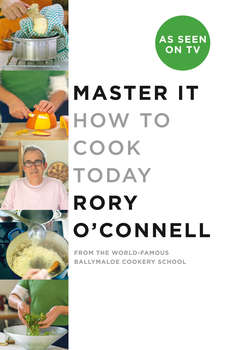Читать книгу Master it: How to cook today - Rory O'Connell - Страница 9
ОглавлениеIntroduction
I love cooking and I love teaching people how to cook – that is why I have written this book.
To cook well, it helps if you love and value food, as this is where it all starts. I cannot separate the cooking from what I am cooking. I feel bound to do well by the ingredients, and learning how to recognise good ones is crucial to becoming a good cook.
By cooking them well I honour the soil, the waters, the air, the planet, the efforts of the farmers, fishermen, producers and purveyors – everyone who got the ingredients to my kitchen.
This repertoire of recipes that I have chosen, though by no means exhaustive, should be a good starting point for the modern cook. The recipes are based on important techniques that all cooks will benefit from. When you master a technique, such as making a shortcrust pastry and lining a flan ring, a year-round soup formula to follow the changing ingredients of the seasons, using gelatine, making mayonnaise and so on, you open up a huge range of possibilities. That is the aim of this book – to demystify; to arm you with skills; to help you avoid the mistakes that my cooks, students and indeed I myself have made; to cook lovely food.
I have chosen my words carefully, highlighting the crucial ones to describe the particular details of a technique or the distinguishing features of a good ingredient.
This is not a ‘chuck it in and see how it goes’ book. I find that approach irksome and unfair, as unless the cook is utterly instinctive and much practised, this approach is fraught with pit falls. Food is too precious and expensive for that sort of game of chance.
So many times, I have witnessed the wide-eyed amazement and delight of a cook who, when finally cajoled into reading, weighing, heating and timing a set of ingredients, has produced a dish that has previously eluded them.
My approach to cooking is simple and not new. Use the best ingredients you can find, get organised and follow the recipe. A potter will have his own recipe for success and will measure his carefully chosen clay, set his kiln at the correct temperature, shape his pots and bake them for the correct length of time. If he doesn’t follow all of the steps, he will most likely have an oven full of pieces of pot rather than the desired perfectly formed vessel. So it is with cooking.
On a deeply personal level, I am charmed by what the earth produces to nourish and pleasure us. I am thrilled by the unconventional beauty of a cabbage leaf, the cross-section of a kiwi fruit closely observed, the heady smell and ticklish feel of a peach, the razor-like edges and sharp fizzing flavour of a verbena leaf, the sound of an egg shell being cracked and an egg spluttering in hot butter, the intensely modern shape and markings of a mackerel. I love it all.
Cooking is my beautiful game, my centre court, my George Best moment. Few things make as much sense to me as cooking the ingredients that fuel and pleasure us. Nothing else grounds me as cooking does – it makes me happy.
A note on cream
In Ireland, the cream I generally use, and the one that is most widely available, is called ‘fresh cream’ with a fat content of 35–40%, I refer to it in the recipes as ‘regular cream’. It is a good all-rounder, rich enough for whipping and for use in sweet and savoury sauces and in ice cream. It is similar to the British ‘whipping cream’ but you can also use double cream in its place.
Spoon measurements
All spoon measurements in this book are rounded unless stated otherwise. ‘Rounded’ means the same volume of ingredient on top of the spoon as below. For example, a rounded spoon measurement is the same as two level spoon measurements.
Oven temperatures
All oven temperatures in this book are for conventional ovens. If you have an exclusively fan oven, refer to your oven manual for instruction. The general rule is that you subtract 20°C (about 36°F) from the recommended temperature when using a fan oven.
